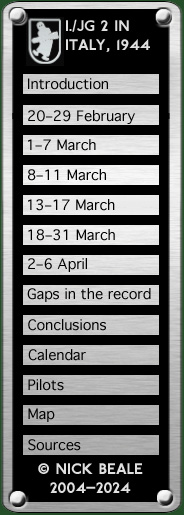
|
||
In five operations German ground attack aircraft engaged with good results vehicle traffic, troop concentrations, a bridge and an ammunition dump in the Cassino area. According to reports so far, air defence forces shot down 32 enemy aircraft, 21 of which were four-engined. Our reconnaissance aircraft screened the west coast. Ob. Südwest The Gruppe flew an early morning "direct escort" for SG 4 to Cassino on 18 March, Lemke claiming a Spitfire and Uffz. Bielohlawek another. One was also claimed by Lt. Bruhe of 5./SG 4 at an altitude of just 20 metres. Another mission to Cassino late in the afternoon—apparently escorted by I./JG 2, III./JG 53 and II./JG 77—also ran into opposition. The I./JG 2 again claimed two Spitfires and Lt. Kulpa of Stab II./SG 4 another. In fact, the 31st FG lost only one destroyed and one damaged from the 112 sorties it put up that day while claiming six Fw 190s and a Bf 109 destroyed; an Fw 190 probable; and four Fw 190s damaged. Unteroffizier Kuno Dollenmaier of 4./JG 2 was killed, as were a pilot from Stab II./SG 4 and one from 8./JG 53. Information about Dollenmaier's whereabouts was sought in a signal issued at 19.30 hrs. that evening; his place of death was later recorded as 2 km north of Pastena (about 28 km west of Cassino). The same message had asked whether anyone had seen a Thunderbolt crash at 12.52 hours between Roccasecca dei Volsci and Cassino. The aircraft had been had last been seen falling and giving off light-coloured smoke after being shot up by fighters but does not seem to correspond in type or timing to any known loss in air-to-air combat in this area, either on the 18th or the day before. 1/Lt. Carroll A. Pryblo: I was leading a section of four aircraft on patrol of the Cassino area on 18 March 1944, with Lt O’Brien as my wing man. At approximately 1730 hours, I was flying over Ceprano in pursuit of enemy aircraft and I noticed Lt O’Brien’s aircraft still in position and apparently perfectly all right. A minute or two later Lt O’Brien contacted me by radio saying he was no longer with me. I looked around but could not find his plane. Nothing was seen or heard of Lt O’Brien after that. Among the USAAF claims were two by the 308th FS (one of these by 1/Lt. Richard Hurd) and two by the 307th FS. Later in the day, 307th FS made two more claims, one of them by Pryblo. British and American Spitfires had several engagements with hostile aircraft, over Cassino, Anzio and Ortona on the Adriatic coast on the 19th. The MATAF operations/intelligence summary’s verdict was “enemy throughout day not aggressive” yet the prolific Lemke claimed to have shot down three more Spitfires in the course of the following morning and Lt. Großfuß (who was awarded the Ehrenpokal during March) claimed another. All these actions were reported as occurring north west of Rome. Strength on 20 March was 7 (3) Bf 109 and 12 (5) Fw 190. Activity was limited on 21 March: 20 Bf 109s of III./JG 53 scrambled at about 15.15 against an Allied formation north of Orbetello but did not make contact and the Gruppe reported that a ground attack operation was flown against heavy motor transport south of Cassino. According to an Ultra decrypt, one victory was claimed by III./JG 53 on the 21st. The 31st FG had two contacts with small groups of Bf 109s, claiming an over-optimistic 4–0–1. At 07.05, 1/Lt. John C. Gfeller (307th FS) claimed to have damaged a "109E" from a pair encountered over Anzio. At 14.05 1/Lt Lawrence N. Guarino (308th FS) claimed another "109E" near Pontecorvino; 2/Lt. James A. Jacobs claimed one in the Cassino area, and apparently also at this time, 2/L.t Youngblood N.H. Ricks claimed one as well. Two more were claimed in the Pignataro Interamna (FR) area by Lt Richard F. Hurd. From 4./JG 2, Uffz. Hermann Kämmlein was killed in combat with six Spitfires, 7 km south of Cassino. North east of Rome, a Spitfire was claimed by Fw. Herbert Penz of the 2. Staffel at 09.34 hours.
Unteroffizier Helmut Kölbach of 4./JG 77 was shot down and captured on the 22nd (he had already been shot down over German-held territory on the 19th) telling his interrogators about: The new FW 190 Gruppe I./JG 2, which has operated successfully for three weeks in Italy is reported to have 40 victories to its credit, amongst them 4-engined Allied bombers. The armament is said to include, besides two 13mm MG 131, 4 cannon MG 151 of 20 mm. These cannon are distributed as follows: two in the upper part of the nose, and two in the wing roots. From the body of a pilot thought to be from I./JG 77, Allied Intelligence retrieved a list of callsigns which “confirm the presence in Italy of I./JG 2.” These were Trommelfell (ear drum), Mansarde (attic) and Pilatus (Pilate) and were thought to be used at different times of the month. The fighter control station in the south was Bleistift (pencil). Oberfeldwebel Hartmann flew a mission to Cassino on the afternoon of the 23rd, looking for artillery spotter aircraft but finding none owing to the bad weather which also prevented any ground attack operations by Fliegerführer 2 that day. continued on next page...
|
||||

